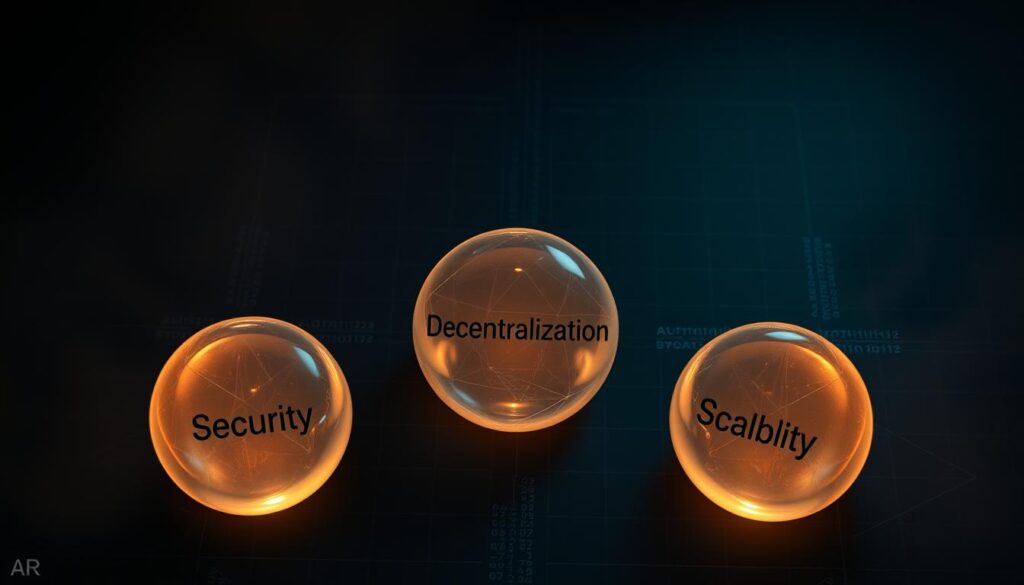Now Reading: What is Blockchain Trilemma Security Decentralization Scalability Explained
- 01
What is Blockchain Trilemma Security Decentralization Scalability Explained
What is Blockchain Trilemma Security Decentralization Scalability Explained

Digital ledger technology faces a fundamental design challenge. Networks struggle to balance three core properties at once. This concept, known as the trilemma, presents a major hurdle for widespread adoption.
Ethereum’s co-founder, Vitalik Buterin, popularized this idea. He noted that a system can only fully optimize two of three essential features. These features are distributed control, robust protection, and high transaction capacity.
This problem has deep roots in computer science. It connects to the CAP theorem from decades ago. That theorem showed similar trade-offs for distributed data stores.
Solving this puzzle is critical for the future of crypto. Systems like Visa handle immense volume securely. For digital assets to compete, networks must overcome these inherent limitations.
This is not just a theoretical issue. It’s a practical barrier affecting performance and user experience. The entire industry focuses on innovative solutions to this balancing act.
Key Takeaways
- The trilemma describes the difficulty of achieving three key properties simultaneously in a distributed network.
- Vitalik Buterin brought this concept to the forefront of digital currency discussions.
- It evolved from earlier computer science principles, specifically the CAP theorem.
- Overcoming this challenge is essential for competing with traditional, centralized payment systems.
- Different projects within the ecosystem prioritize various aspects, leading to diverse technological approaches.
- This fundamental limitation impacts transaction speed, network resilience, and overall usability.
Introduction to the Blockchain Trilemma
The fundamental trade-off facing decentralized systems represents one of crypto’s most enduring puzzles. This constraint shapes how digital asset platforms evolve and function.
Overview of Key Concepts
Distributed ledgers typically achieve only two of three vital properties simultaneously. This limitation creates distinct network configurations with specific strengths and weaknesses.
Some systems prioritize robust protection and distributed control but sacrifice speed. Others focus on high throughput and safety but centralize authority. A third approach emphasizes speed and distribution but compromises on safeguards.
| Network Type | Strengths | Compromises | Example |
|---|---|---|---|
| Secure & Decentralized | High protection, distributed control | Lower transaction capacity | Bitcoin network |
| Fast & Secure | High throughput, strong safeguards | Centralized governance | Enterprise solutions |
| Fast & Decentralized | Quick processing, distributed nodes | Reduced security measures | Some newer platforms |
Relevance in Modern Blockchain
This challenge gains importance as digital currencies seek broader acceptance. Billions of potential users require systems that balance all three properties effectively.
Developers continuously create innovative mechanisms to address these limitations. Layer solutions and architectural improvements bring networks closer to optimal performance.
The entire industry dedicates significant resources to solving this puzzle. Success could enable global applications across finance, logistics, and digital services.
Foundations of Blockchain: Security, Decentralization, and Scalability
Modern crypto networks must navigate a complex relationship between three fundamental architectural requirements. These pillars form the foundation upon which all distributed systems are built.
Defining Security in Blockchain
Robust protection mechanisms prevent unauthorized changes and malicious attacks. Bitcoin’s Proof-of-Work requires immense computing power to alter history.
The August 2020 Ethereum Classic incident showed real consequences when security fails. Hackers reorganized blocks causing significant losses.
Understanding Decentralization
Distributed control across thousands of independent nodes prevents single entity dominance. This creates censorship-resistant environments.
Bitcoin demonstrates this with tens of thousands of participants worldwide. No authority can manipulate the ledger.
Scalability and Throughput Challenges
Transaction capacity remains a major hurdle for mainstream adoption. Traditional systems like Visa handle thousands of transactions per second.
Popular crypto events like CryptoKitties revealed network limitations. Congestion leads to slow processing and high fees.
| Property | Core Function | Real-World Example | Limitation |
|---|---|---|---|
| Protection | Prevents malicious changes | Bitcoin’s mining requirement | Energy intensive |
| Distribution | Eliminates central control | Global node participation | Slower decision-making |
| Capacity | Handles volume growth | Visa’s 20,000 TPS | Base layer constraints |
These three properties create natural tension in system design. Improving one often compromises another aspect.
what is blockchain trilemma security decentralization scalability
A fundamental principle governs the architecture of distributed ledgers: perfect harmony between speed, safety, and distribution is unattainable. Each protocol design inherently prioritizes certain properties while compromising on others. This creates distinct strategic paths for developers.

Bitcoin exemplifies a choice for robust protection and censorship resistance. Its design achieves this at the expense of transaction capacity, processing only a handful of operations per second. This makes it a superb store of value but a slower payment network.
Conversely, platforms like Solana prioritize high throughput. They achieve thousands of transactions per second by requiring powerful hardware for participation. This approach can reduce the ease of running a node, affecting the system’s distributed nature.
Some crypto projects explicitly limit the number of validators to boost performance. The XRP Ledger and Binance Smart Chain use this method, trading widespread distribution for significant speed gains. This is a clear example of a calculated trade-off.
The underlying challenge is simple. A more open and geographically dispersed set of nodes takes longer to agree. This natural delay limits how fast the entire system can work. Making a network faster often means concentrating power, which can increase vulnerability.
These constraints are not failures but fundamental aspects of distributed blockchains. Different use cases justify different priorities, leading to the diverse ecosystem we see today.
Layer 1 Solutions: Enhancing the Base Layer
Fundamental upgrades to the base architecture offer promising pathways for overcoming inherent constraints. These improvements target the core protocol itself rather than adding external components.

Consensus Mechanism Improvements
Major networks are transitioning from energy-intensive Proof of Work to more efficient Proof of Stake. Ethereum’s historic upgrade reduced energy consumption by over 99%.
Validators are now selected based on their stake rather than computational power. This change enhances network capacity while maintaining robust protection.
Sharding and Its Impact on Scalability
Sharding divides the blockchain into smaller parallel chains called shards. Each shard processes transactions simultaneously instead of sequentially.
This approach allows exponential growth in processing capacity. Different shards maintain portions of the data, communicating through cross-shard protocols.
Projects like Zilliqa and NEAR Protocol demonstrate sharding’s potential. These innovative approaches represent significant steps toward solving fundamental limitations.
Layer 2 Innovations: Off-Chain Scaling Techniques
Secondary scaling approaches operate above base protocols to enhance transaction throughput. These solutions process operations away from the main ledger while maintaining connection to it.
This method preserves the underlying system’s robust properties while dramatically increasing capacity. Users experience faster processing times and lower costs.

State Channels and Nested Blockchains
State channels create private pathways for participants to exchange value directly. The Lightning Network demonstrates this technology effectively.
Two parties lock funds using smart contracts, enabling countless instant transactions. Only the opening and closing states record on the main chain.
Rollups and Sidechains Explained
Rollups bundle numerous transactions together for efficient processing. Optimistic variants assume validity while ZK types use cryptographic proof.
Sidechains function as independent networks connected via bridges. Polygon processes operations faster than Ethereum while maintaining periodic checkpoints.
| Solution Type | Key Mechanism | Transaction Speed | Security Model |
|---|---|---|---|
| State Channels | Off-chain private pathways | Instant | Inherited from main chain |
| Rollups | Batch processing with proofs | Very High | Inherited + cryptographic |
| Sidechains | Independent parallel chains | High | Separate consensus |
Real World Examples and Case Studies
Leading crypto projects demonstrate distinct strategies for managing the core trade-offs inherent in their design. Their approaches offer valuable insights into practical problem-solving.

These case studies show how theoretical concepts are applied. They highlight the ongoing evolution of distributed systems.
Bitcoin’s Approach with the Lightning Network
Bitcoin prioritizes robust protection and censorship resistance on its base layer. This results in a slower transaction speed of about seven per second.
The Lightning network addresses this limitation as a secondary solution. Users open payment channels for instant, high-volume transfers off the main chain.
This two-tier system keeps the foundational layer secure and decentralized. Everyday payments gain immense throughput without compromising core principles.
Ethereum’s Transition: From PoW to PoS
Ethereum undertook a historic upgrade known as “The Merge” in 2022. It shifted from energy-intensive mining to a proof-of-stake consensus model.
This change reduced energy use by over 99%. It also increased participation, with over 500,000 validators now securing the network.
The upgrade sets the stage for future enhancements like sharding. This will further boost capacity by splitting the workload across multiple chains.
| Project | Primary Solution | Key Improvement | Impact on Trilemma |
|---|---|---|---|
| Bitcoin | Lightning Network (Layer 2) | Enables instant, low-cost payments | Adds scalability to a secure, decentralized base |
| Ethereum | Proof-of-Stake (Layer 1) | Dramatically increases efficiency and capacity | Enhances scalability and decentralization while maintaining security |
Both paths show a strong commitment to solving fundamental challenges. Their success is critical for broader adoption.
Innovations Shaping the Future of Blockchain
New paradigms are emerging that fundamentally reshape how we approach network architecture. These cutting-edge solutions move beyond traditional Layer 1 and Layer 2 distinctions.
The industry is embracing modular designs that separate core functions into specialized layers. This represents a significant departure from monolithic systems where every node handles all tasks.
Modular Blockchain Designs
Modular architectures divide responsibilities across independent components. Consensus, data availability, and execution become separate specialized layers.
Projects like Celestia demonstrate this approach effectively. They provide consensus and data services as a foundation for custom execution layers.
This specialization allows each component to optimize for specific strengths. Base layers focus on robust protection while execution layers prioritize throughput.
Emerging Trends in Decentralized Networks
The ecosystem is shifting toward interconnected specialized chains. Platforms like Polkadot and Cosmos enable multiple networks to work together seamlessly.
Application-specific chains represent another significant trend. Developers build entire networks optimized for single use cases rather than general-purpose platforms.
Zero-knowledge proof technologies are advancing rapidly. These cryptographic innovations enable both privacy and scalability simultaneously.
As industry analysis shows, these innovations collectively address fundamental limitations. The future points toward ecosystems where different chains handle different functions based on their unique strengths.
Addressing the Trade-Offs and Challenges
Despite significant technological progress, inherent tensions continue to shape the development of distributed ledger systems. This section explores the practical difficulties that arise when trying to strengthen one property without weakening another.
Balancing Security with Scalability
Efforts to boost a network’s speed can unintentionally create openings for malicious actors. Reducing validation steps or accelerating block confirmation times might improve throughput.
However, these changes can leave the system vulnerable. Faster consensus may not allow enough time for global agreement among all participants.
This can lead to chain forks, where different nodes have conflicting transaction histories. The infamous 51% attack becomes more likely if control is concentrated.
Hackers need fewer resources to gain majority power over a less distributed validation process. The 2020 incidents on the Ethereum Classic network are a stark reminder. Attackers successfully reorganized the chain to double-spend coins.
| Scalability Tactic | Potential Benefit | Security Risk Introduced |
|---|---|---|
| Faster Block Times | Higher Transaction Capacity | Increased Fork Risk |
| Lower Transaction Fees | Improved User Accessibility | Vulnerability to Spam Attacks |
| Simplified Validation | Enhanced Processing Speed | Higher Chance of 51% Attack |
Decentralization vs. Network Throughput Issues
Adding more independent nodes strengthens a system’s distributed nature. But this comes with a significant cost to efficiency.
As the number of participants grows linearly, the communication needed between them grows exponentially. This creates a natural bottleneck for transaction speed.
Some projects face an accessibility challenge. Requiring expensive hardware or large financial stakes to run a node ensures robust protection.
Yet, this practice can centralize power among a small number of wealthy entities. The philosophical choice between broad participation and high performance remains a core challenge for developers.
Conclusion
The ongoing quest to harmonize distributed ledger properties continues to drive crypto innovation. While the core challenge remains, the landscape has shifted from viewing it as an insurmountable barrier to a dynamic design puzzle.
Different networks now rationally prioritize aspects based on their purpose. No single project has completely solved the puzzle yet, but substantial progress is evident.
Combinations of base-layer upgrades and secondary scaling techniques demonstrate real-world potential. The collaborative efforts of developers worldwide are gradually addressing these fundamental constraints.
Successfully balancing these properties will unlock mainstream adoption across numerous industries. This progress paves the way for broader applications, including those leveraging privacy-enhancing technologies.
Staying informed about these evolving solutions is crucial for anyone involved in the ecosystem. The future points toward a more scalable and functional digital asset environment.
FAQ
Can a network achieve high throughput without sacrificing decentralization?
Yes, but it is a significant challenge. Solutions like sharding on Layer 1 or rollups on Layer 2 aim to increase transaction speed while distributing control among many participants. However, these approaches require careful design to prevent creating central points of failure.
How does Proof of Stake improve scalability compared to Proof of Work?
A: Proof of Stake consensus mechanisms, like the one Ethereum adopted, do not require massive computational power. This reduces energy consumption and allows the system to process transactions faster, directly addressing throughput limitations inherent in Proof of Work systems.
What is the primary risk of prioritizing scalability above all else?
The main risk is reduced security and increased vulnerability to attacks. If a few powerful nodes or a single entity control most of the network‘s data processing, it becomes a target for attackers, compromising the integrity of the entire chain.
Are state channels considered a secure scaling solution?
A: State channels are generally secure for their specific use case. They enable off-chain transactions between parties, which are later settled on the main chain. This reduces network load. Their security relies on the underlying mainnet’s robustness and correct implementation by users.
How do modular blockchain designs address the core challenge?
A: Modular blockchain designs separate key functions like execution, consensus, and data availability. By specializing, each layer can be optimized independently. This architecture aims to enhance overall system performance, speed, and ability to handle more information without a single layer becoming a bottleneck.















